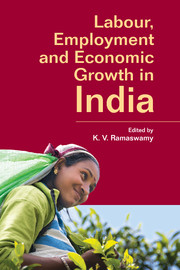Book contents
- Frontmatter
- Dedication
- Contents
- List of Tables and Figures
- Preface
- Part 1 Economic Growth and Employment
- 1 Introduction and Review of Issues
- 2 India's Labour Market during the 2000s
- 3 Services-led Growth and Employment in India
- 4 Growth, Structural Change and Poverty Reduction
- 5 Age Structure Transition, Population Ageing and Economic Growth
- 6 Labour Intensity in Indian Manufacturing
- 7 Gender Discrimination in Manufacturing Employment in India, 1999-2009
- Part 2 Employment and Labour Law
- Contributors
- Index
4 - Growth, Structural Change and Poverty Reduction
from Part 1 - Economic Growth and Employment
Published online by Cambridge University Press: 05 June 2015
- Frontmatter
- Dedication
- Contents
- List of Tables and Figures
- Preface
- Part 1 Economic Growth and Employment
- 1 Introduction and Review of Issues
- 2 India's Labour Market during the 2000s
- 3 Services-led Growth and Employment in India
- 4 Growth, Structural Change and Poverty Reduction
- 5 Age Structure Transition, Population Ageing and Economic Growth
- 6 Labour Intensity in Indian Manufacturing
- 7 Gender Discrimination in Manufacturing Employment in India, 1999-2009
- Part 2 Employment and Labour Law
- Contributors
- Index
Summary
Introduction
After three decades of generally low growth, the Indian economy experienced a growth acceleration that started in the 1980s. Growth in gross domestic product per capita, only 1.4 per cent annually from the 1950s through 1970s, accelerated steadily from average annual growth rates of 3.5 per cent in the 1980s, to 3.7 per cent in the 1990s, and 5.5 per cent in the new millennium. While a slowdown in growth since early 2011 has led to a vigorous debate about the Indian economy's ‘growth potential’ and its ability to sustain growth rates of around 6 per cent and higher (in per capita terms) for long stretches of time, a more enduring debate has been about the inclusiveness of India's growth.
What has been the impact of India's growth on poverty? What factors explain the strength of the growth–poverty relationship in India? What, if anything, can be done to make the growth process more effective in reducing poverty? This chapter examines these questions through the lens of structural transformation – i.e. changes in an economy's structure of output and employment. Such an approach is important since, although there are many causes of poverty, ultimately the poor are poor because the work they do earns them so little. Consequently, understanding the relationships between growth, changes in the structure of output and employment, and poverty reduction is crucial for policymaking.
The chapter provides a snapshot of the empirical relationship between economic growth and poverty reduction in India since the 1980s. (A detailed discussion of data and variable construction is provided in the Appendix.) The snapshot indicates that while growth in India has been associated with an unambiguous decline in poverty, the extent of poverty reduction in India has been considerably less than in other high-growth economies in Asia. The next section then considers the proximate factors that can explain the relatively weak link between growth and poverty reduction in India.
- Type
- Chapter
- Information
- Labour, Employment and Economic Growth in India , pp. 91 - 126Publisher: Cambridge University PressPrint publication year: 2015
- 3
- Cited by



